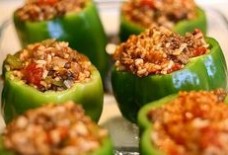A garden grows amid the daily dangers of a siege in Syria
In a dark kitchen, by the flickering light of a single safety candle, two men bundled in hats and jackets against the cold put on an impromptu video satire: live from Yarmouk, at the southernmost edge of Damascus, a cooking show for people under siege.
“This is the new dish in the camp of Yarmouk. It hasn’t even hit the market yet,” said the man on the right, 40-year-old Firas Naji, the blunt and humorous host.
He picked up a foot-long paddle of sobara, Arabic for prickly pear cactus. Holding it carefully by one end to avoid thorns, he displayed first one side and then the other for the camera.
“In the U.S., they get Kentucky [Fried Chicken], hot dogs. In Italy, spaghetti and pizza,” he said, his raspy voice caressing the names of unattainable foods. “Here in Yarmouk, we get sobara.”
“It’s not enough we have checkpoints in the streets and shelling,” he added, laying the cactus back on the counter with a sad laugh. “Even our cooking has thorns.”
When the Islamic State in Iraq and the Levant (ISIL) and Jabhat Al-Nusra (the Nusra Front) swept in and seized control of Yarmouk last month, they were fighting people who had been under siege by Syrian President Bashar al-Assad’s regime for more than two years. Since December 2012, the 18,000 people trapped in this neighborhood have been living with hardly any electricity or fuel. They have had no running water since September 2014. They had so little food that at one point a Muslim cleric in Yarmouk issued a ruling allowing people to eat the flesh of donkeys, dogs and cats.
But one thing they have always had in Yarmouk, which was originally a camp for displaced Palestinians, is sabr. Roughly translated, sabr is the patience and perseverance that gives the prickly pear cactus its Arabic name. For Palestinians, the sobara — thorny, tough, often planted at the borders of vegetable gardens as a living fence — is a symbol of resilience.
Under siege by the regime and now by insurgents, Yarmouk’s forgotten civilians have been fighting the medieval weapon of hunger with creativity, humor and the ultimate grass-roots resistance strategy: gardens.
A matter of life and death
Yarmouk is one of a handful of neighborhoods, villages and towns being held under siege in the four-year Syrian conflict. Across the country, civilians under siege have been devising creative survival strategies for feeding themselves and their neighbors. Many of them are based on age-old agrarian practices like foraging, communal kitchens and community gardens. In Yarmouk a new generation of urban gardeners has defied bullets and artillery fire to cultivate as many as seven large community plots and dozens of smaller kitchen gardens.
“Most of the people in Yarmouk do gardening today,” said Abdallah al-Khateeb, a 25-year-old Yarmouk native and student-turned-activist-turned-gardener, over Skype, in an interview conducted before the ISIL takeover. “Most of them have made little farms inside their houses or close to their homes.”
Source: america.aljazeera.com


